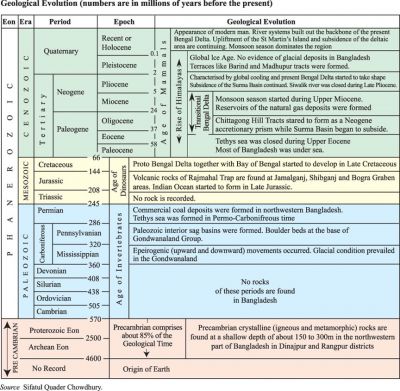Geological Evolution
Geological Evolution The geological time scale divides the total time span of earth's 4.6 billion years of existence into units and sub-units on the basis of rock records. It basically includes four eras, such as, Precambrian, Palaeozoic, Mesozoic and Cenozoic. The eras are subdivided into periods and the periods into epochs.
Precambrian is the longest era, encompassing about 85% of the age of the earth and lasting from 4,600 million years to about 570 million years before the present. The rocks of the era are mostly crystalline igneous and metamorphic types and form the bases of sedimentary basins. Only very primitive types of life, mostly unicellular organisms existed in the ocean during this time. Rocks of the Precambrian era, mostly granite, granodiorite and gneiss, are found at a shallow depth of about 150 to 300m in the northwestern part of Bangladesh in the dinajpur and rangpur districts.
The Palaeozoic era lasted from about 570 million years to about 245 million years before the present era. It is divided into six periods named, from older to younger, as Cambrian, Ordovician, Silurian, Devonian, Carboniferous and Permian. It is known as the age of invertebrates because they were the predominant life form on earth during that time. No rocks of the Cambrian to Devonian periods are found in Bangladesh. However, the structural features created in the Carboniferous time in the bengal basin are extremely epeirogenic in nature. During the Lower Carboniferous time glacial condition prevailed in the Gondwanaland. In the Upper Carboniferous time the continuous lateral tension and downwarping of the continental crust resulted in the formation of a larger Palaeozoic interior sag basin and due to the great diastrophism the Gondwanaland started to downwarped and created faulted troughs in the Precambrian basement complex. In the Bengal Basin these faulted troughs are present in the western foreland shelf in which the Gondwana rocks with coal beds were preserved. The Carboniferous sediments in the Bengal Basin are not yet recognised. But it is thought that the boulder bed at the base of the gondwana group might have been started to develop during the Upper Carboniferous time.

During the Permian period large river basins with swampy and thickly vegetated land existed in the northwestern part of Bangladesh. This resulted in the formation of sandstone, coal beds and shale layers that are now found in the subsurface in the area. These coal layers form commercial coal deposits in northwestern Bangladesh.
The Mesozoic Era lasted from about 245 million years to 66 million years before the present. It is divided into three periods known as Triassic, Jurassic and Cretaceous. It is known as the age of dinosaurs because of their dominance on land during this time. Triassic rocks have yet to be found within Bangladesh. During the Jurassic or Lower Cretaceous period a large volcanic eruption took place nearby resulting in the deposition of volcanic rock layers in northwestern Bangladesh particularly at jamalganj, shibganj and bogra graben areas. These rocks are called the Rajmahal Trap and consist of black coloured basalt that are now found in the subsurface.
The Cenozoic Era runs from 66 million years to the present and is divided into two periods named as Tertiary and Quaternary. The Tertiary period (66 million years to 2 million years before the present) is divided into five epochs named as Palaeocene, Eocene, Oligocene, Miocene and Pliocene. The Quaternary period is divided into two epochs named Pleistocene and Holocene. Pleistocene is the early epoch covered about 2 million years before the present and Holocene is the last epoch, covered 10,000 years before the present. The Cenozoic era is known as the age of mammals. Among the mammals, Elephus, Equs and Leptobos are the important animals, which appeared during this period.
For Bangladesh, the most important one is the Cenozoic era, because most of the sedimentary layers as well as the geological structures of the country were formed during this era. The Cenozoic tectonic evolution of Bangladesh mainly took place at the end of the Eocene, Middle Miocene, close of the Pliocene and the early Pleistocene. During the early Tertiary period (Palaeocene and Eocene epochs) most of Bangladesh was under open marine condition, which resulted in the formation of fossiliferous limestone and shale with some sandstone. During the late Tertiary period (Oligocene, Miocene and Pliocene epochs) the open sea retreated to the south in response to the uplift of the himalayas in the north and river systems built out a large deltaic land that formed the backbone of the present bengal delta. Huge successions of alternating sandstone and shale layers now found on the surface and in the subsurface of eastern and southern Bangladesh were formed in this delta environment during the Tertiary period.
With the beginning of the Quaternary period, the earth experienced severe cooling and the advance of glaciers over the land. For this reason the Pleistocene epoch is known as the ice age. During glacial periods sea level fell down and during interglacials again rose up. Hominids or Homosapiens, particularly, appearance of modern man is the striking characteristic of the Quaternary. There is however, no evidence of glacial deposits in Bangladesh during the Pleistocene time. But the Himalayas were glaciated and the melt water was flowing over Bengal plain through deeply incised river valleys towards the bay of bengal. Hence, by that time, Bengal plain was acting like an outwash plain. In fact, Holocene alluvial and Pleistocene fluvial deposits occupy three-fourths of the country. However, the present course of the ganges through Bangladesh seems to be a recent event. Most of Bangladesh took its present shape during the Quaternary period and a river dominated geomorphic system was established. [Badrul Imam and Sifatul Quader Chowdhury]
